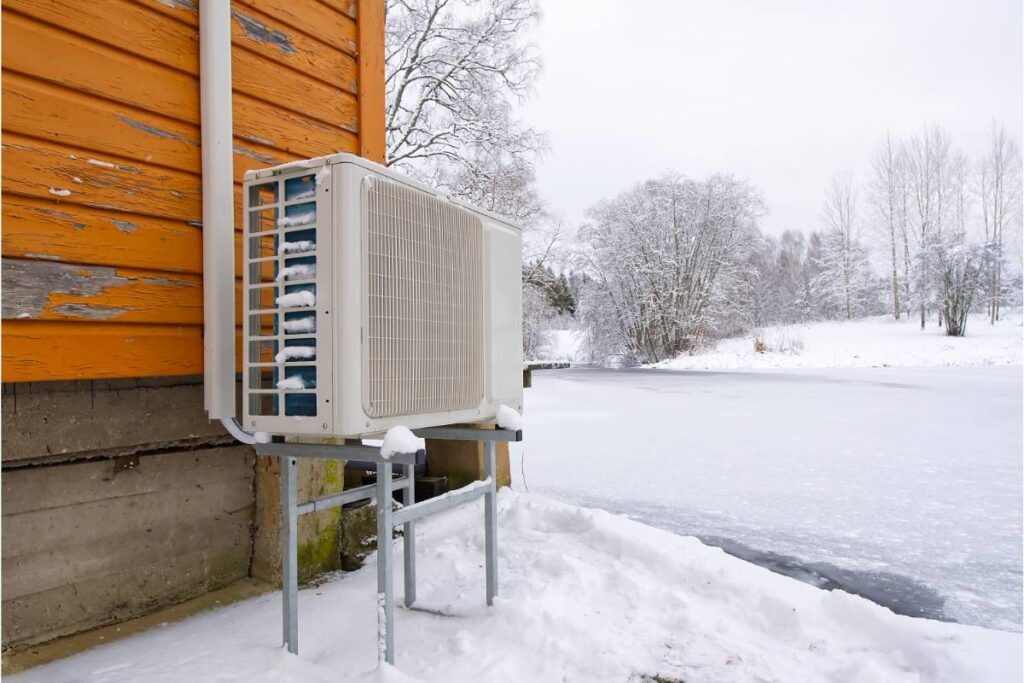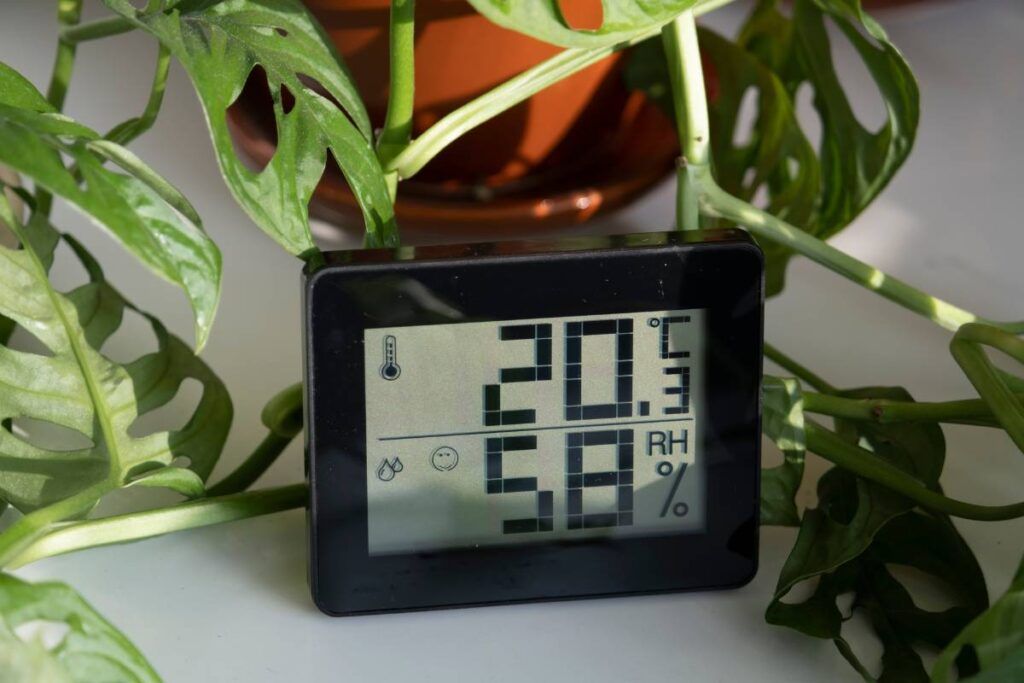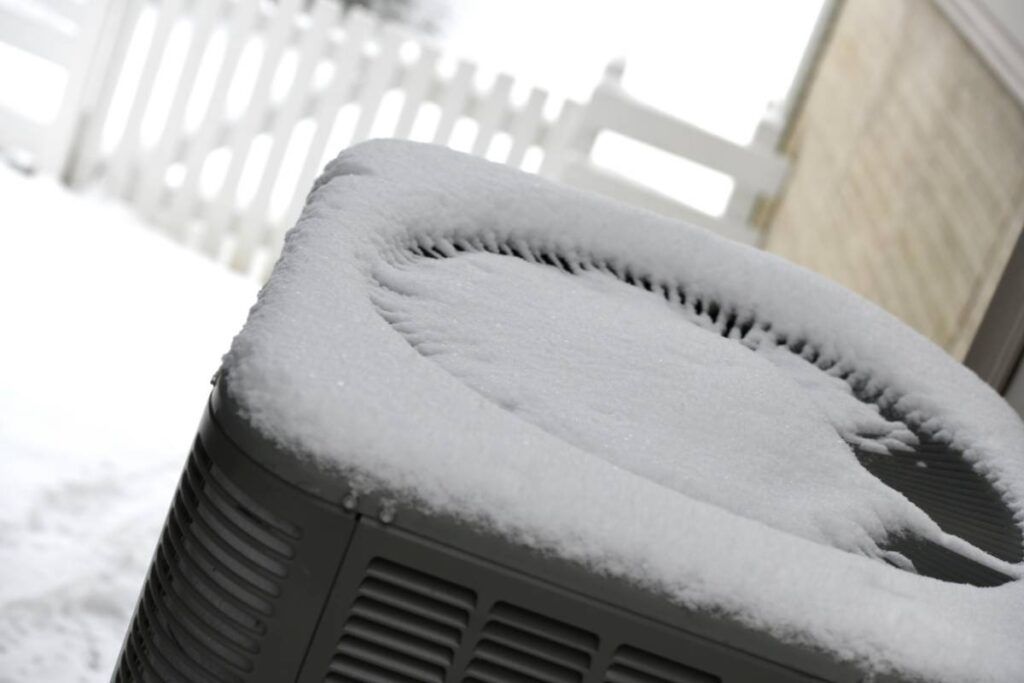Heat pumps keep our houses warm and comfortable in the winter season. But a common query about the heat pump is its efficiency during freezing temperatures. Will it work below zero degrees? Let’s find out.
A heat pump will never stop working in cold temperatures, even if it goes below 0°F. The unit may have difficulty distributing enough warm air, but it will keep running below freezing temperature. However, if the outdoor unit is completely covered with ice, your heat pump might shut off.
Since zero degrees is quite a low temperature, most heat pumps will struggle to circulate the warm air. This guide will explain the heat pump’s efficiency in freezing temperatures and at what temperatures it will stop working properly.

Check out our list of top-handpicked products for all your electrical, appliance, and HVAC system needs to keep your home running smoothly.
This post includes some affiliate links.At what temperature will the heat pump be effective?
Heat pumps are effective when the outdoor temperature is above freezing, i.e., above 32°F.
Once the temperature drops below 30°F, the heat pump will lose its efficiency and ability to provide adequate heat.
The unit starts building ice when the temperature drops below 60°F to 50°F.
When the temperature goes beyond 30°F, the heat pump will start a defrost cycle which helps in melting the ice buildup of the unit.
Though the heat pumps are made to provide you with warm air, there are some drawbacks.
The unit has limitations due to the heat production process.
Instead of creating heat, like a furnace, it pulls in warm air from outside.
Once the unit loses its effectiveness, its efficiency will lose, and the heat pump will face difficulty producing heat.
Heat pumps act as both heating and cooling systems.
In hot temperatures, the effective temperature for the heat pump is 70 to 80°F.
In the cooling system, the effective temperature of the heat pump ranges between 50 and 60°F.
However, the unit will remain effective up to 30-40°F.
If the temperature drops below 30-32°F, it will struggle to produce heat and lose efficiency.
What is the heat pump’s lowest temperature?
The answer to the question is contradictory.
Some house owners claim that the heat pump stops working at temperatures between 5°F and 20°F.
In contrast, others say that heat pumps never stop working, even if the temperature goes below 0°F.
But, it provides less warmth than before.
The old heat pumps were not that efficient.
So, they used to stop working whenever the temperature went below 20°F to 30°F.
The US department of energy has challenged the heat pump producers with two goals:
- Creating a cold climate heat pump optimized for 5°F.
- Creating a cold climate heat pump optimized for -15°F.
It means the heat pumps should have the lowest temperature tolerance of either 5°F or -15°F.
If your heat pumps do not have these features, your unit will stop working whenever the temperature is between 5°F and 20°F.
It won’t wait for the temperature to fall to 0°F.
In modern times, heat pumps have progressed greatly in efficiency and technology.
Today, the standard heat pumps will work if the temperature goes below 0°F.
The lowest temperature for them is -4°F.
But, it will be very hard for the unit to distribute heat if the temperature is around -35 to -40°F.
The unit may stop working.
Since 20°F is considered the lowest temperature for most heat pumps, let’s look at the COP level of the heat pumps at 20°F:
- The standard heat pump would have a 2.4 COP value at 20°F. So, the efficiency would be 240%.
- If you have a low-temperature heat pump, you get 2.5 COP, which means 250% efficiency.
Since the efficiency is quite better, your heat pump will work well during such low temperatures.
What if the temperature drops to 10°F?
- At 10°F, an average heat pump will have 1.9 COP, which means 190% efficiency.
- A low-temperature heat pump will have 2.3 COP, i.e., 230% efficiency.
Your heat pumps should not stop working at such temperatures.
However, whether the heat pump will work efficiently or not depends on the heat pump size.
Buy a size according to the needs of your house.
Will the heat pump work below zero degrees?

In the old days, heat pumps had less technology than recent ones.
If you have an old heat pump, it will face difficulty in giving you warm air below zero degrees.
When the temperature drops below 32°F, it will lose its efficiency and won’t work properly.
But modern heat pumps come with high efficiency and lots of technologies.
So they will not struggle to provide heat like the old units.
Below 0°F, the heat pump will still heat your house better than the gas heating or standard electric heating systems.
A heat pump never stops working, even if the temperature is below zero degrees.
The mini-split heat pumps can run in low temperatures.
However, no matter how efficient your heat pump is, the heating energy will decrease below 0°F.
At a specific temperature, the heat pump’s COP (Coefficient Of Performance) will fall, and you might have to shift from the heat pump to a furnace.
A heat pump should provide at least 100% efficient heat in your house.
An average heat pump contains 3.7 COP at 47°F, which means 370% efficiency.
The electric space heaters have 1.0 COP.
When the temperature is below 0°F, the COP value of the standard heat pump will be 1.0, like the electric or gas heaters.
The modern heat pumps will have 2.2 COP at 0°F.
So, your unit will work even below 0°F.
Here is a small guide about the efficiency of the heat pumps at 0°F and below zero degrees:
Heat pump efficiency at zero degrees
- A standard heat pump will have 1.2 COP, i.e., 120% efficiency.
- A good low-temperature heat pump will have 2.2 COP, i.e., 220% efficiency.
Since the efficiency is good, your heat pump will not stop working at zero degrees.
So, what about below 0°F?
Heat work efficiency below zero degrees
- A standard heat pump will contain 0.5 COP. The efficiency would be around 50%.
- A good low-temperature heat pump contains 0.8 COP, which means 80% efficiency.
The efficiency will be low at below zero degrees.
The unit may work harder to give you the desired heat pump, but it will continue running.
The warm air may be late to reach you or less warm than you, except the unit won’t stop distributing the warm air.
If your heat pump is struggling to provide enough warm air, you can manually turn on the secondary heat source in your unit.
Why do you need secondary heat?

Some heat pumps will have reduced efficiency in the winter, especially when the temperature goes below 0°F.
So, it is recommended to include secondary heat if you live in very cold climates where the temperature goes below freezing.
When the heat pump loses its capacity to work efficiently, it will struggle to distribute warm air.
It will lead to longer cycles, overheating, and damaging the heat pump components.
Your unit may even shut down and increase the energy bills due to longer cycles.
When to use the secondary heat?
Modern heat pumps do not need to turn the secondary heat source on manually.
The modern units have a switch that turns on the auxiliary heat automatically.
It kicks when the outside temperature is too cold, and your heat pump fails to bring adequate heat inside your house.
It is a supplement heat source that runs on current.
If your heat pump does not have an automatic setting, your thermostat should have an auxiliary setting.
Please turn it on whenever the temperature drops out of balance.
Remember to turn off the auxiliary heat setting after the temperature returns to normal.
The emergency heat is slightly different from the auxiliary heat.
The emergency heat also stops the primary heat source, but it starts when your unit is not functioning anymore.
In the emergency heat setting, the primary heat source will remain off.
But the gas or electric components will keep running to keep your house warm.
Do not rely on the emergency heat for too long.
You must call an HVAC expert to fix your unit whenever your unit stops functioning.
Why does cold weather affect the efficiency of the heat pumps?

The heat pump absorbs the heat and transfers it to a different location.
During the summer, the refrigerant absorbs heat and pumps out cold air outside.
In the winter, the refrigerant will cool down, and the air will be warmer than the refrigerant.
The heat pump will absorb the heat difference and pump it inside your house.
A heat pump does not create warm air like a furnace.
The pump absorbs the outside air.
Once the temperature drops too low, it becomes more difficult for the refrigerant to cool down than the ambient air.
So, it will take time to catch and compress the heat and warm up your house.
It occurs when the outside temperature is too low.
However, the heat pump should still work. It has to work harder than it normally does.
Gas or electric heater vs. Heat pump efficiency
As you can see, the heat pumps’ efficiency is quite less when the temperature goes below 0°F.
If you live in regions with temperatures below 0°F, buy a furnace instead of relying on the heat pump.
Since heat pumps are cheaper and do the job of heating and cooling, many people prefer heat pumps over heaters.
But heaters are important in cold regions.
The gas or electric heaters’ efficiency is much better than the heat pumps.
The heat pumps are sometimes better, but furnaces are better for extremely low temperatures.
Here is the furnaces’ efficiency in different temperatures:
20°F
- An electric furnace contains 1 COP, which means 100% efficiency.
- A 90 AFUE gas furnace will be 90% efficient.
If you look at the heat pump’s efficiency at 20°F, you will see that it is 100% better than the gas or electric furnace.
It is because the heat pumps do not burn electricity to create heat.
The heat pumps use electricity to pump heat from the outside temperature.
10°F
- An electric furnace has 1 COP, which is 100% efficient.
- A 90 AFUE gas furnace will provide 90% of efficiency.
Here too, heat pumps are a better choice than furnaces.
0°F
- An electric furnace has 1 COP or 100% efficiency.
- A 90 AFUE gas furnace can convert 90% energy into heating output.
Here, the efficiency of the standard heat pumps and electric furnaces has very little difference.
Below 0°F
- The electric furnace contains 1 COP or 100% efficiency.
- A 90 AFUE gas furnace can convert 90% of heat output.
Here, the furnaces have surpassed the heat pumps to a great level, nearly around 50%.
So, if you live in areas where the temperature drops below 0°F, you should prefer gas or electric furnaces over heat pumps.
Final thoughts

Heat pumps are meant to provide warm air in the winter and cool air in the summer.
If your region receives a temperature below 0°F in the winter, your heat pump will not stop running.
But it will struggle to give you adequate warmth.
The old heat pumps may stop running once the temperature drops and remains between 5°F and 20°F.
However, modern heat pumps will work as they are highly efficient, and most have the lowest temperature of -15°F.
If your heat pump cannot warm you up in the winter, you need to start the secondary heat source, which is the auxiliary heat.
Generally, the auxiliary heat kickstarts automatically once it senses the outside temperature to be too low.
If you need to start manually, your thermostat should have the setting.
Do not completely rely on the COP value and efficiency discussed in the article.
The efficiency may increase or decrease based on the heat pump size.
Do heat pumps constantly run in cold weather?
A heat pump will run continuously if the weather is too cold. Since it starts losing its efficiency in cold weather, it will constantly run until it gives you the desired temperature.
When does the auxiliary heat trigger?
Generally, the auxiliary heat is triggered when it senses the outside temperature to be too low. In most cases, it turns on when the temperature goes below 35°F.
